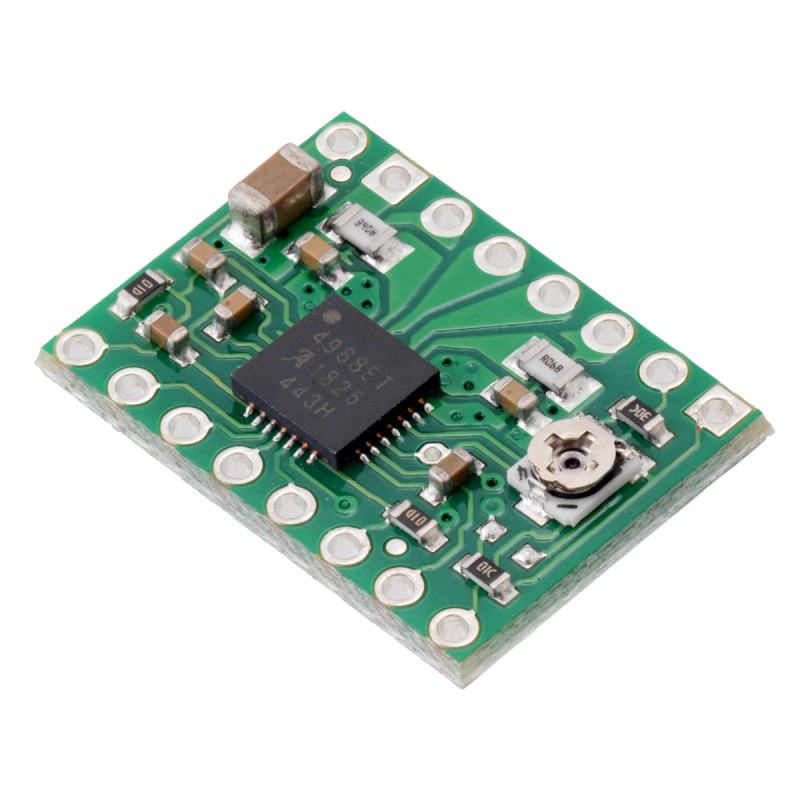

A4988 Stepper Motor Driver Carrier
The A4988 stepper motor driver carrier is a breakout board for Allegro’s easy-to-use A4988 microstepping bipolar stepper motor driver and is a drop-in replacement for the A4983 stepper motor driver carrier. The driver features adjustable current limiting, overcurrent protection, and five different microstep resolutions. It operates from 8 – 35 V and can deliver up to 2 A per coil.
Limited stock until mid-August: We are limiting immediate shipments to five (5) units per order until our supply of these units improves. Orders for larger quantities will be accepted but put on backorder.
Limited stock until mid-August: We are limiting immediate shipments to five (5) units per order until our supply of these units improves. Orders for larger quantities will be accepted but put on backorder.
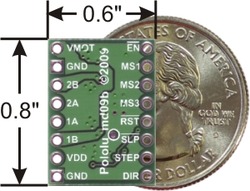 |
| A4983/A4988 stepper motor driver carrier with dimensions. |
|---|
This product is a carrier board or breakout board for Allegro’s A4988 DMOS Microstepping Driver with Translator and Overcurrent Protection; we therefore recommend careful reading of the A4988 datasheet (380k pdf) before using this product. This stepper motor driver lets you control one bipolar stepper motor at up to 2 A output current per coil (see the Power Dissipation Considerations section below for more information). Here are some of the driver’s key features:
Like nearly all our other carrier boards, this product ships with all surface-mount components—including the A4988 driver IC—installed as shown in the product picture.
We also sell a larger version of the A4988 carrier that has reverse power protection on the main power input and built-in 5 V and 3.3 V voltage regulators that eliminate the need for separate logic and motor supplies.
Some unipolar stepper motors (e.g. those with six or eight leads) can be controlled by this driver as bipolar stepper motors. For more information, please see the frequently asked questions. Unipolar motors with five leads cannot be used with this driver.
The A4988 stepper motor driver carrier comes with one 1?16-pin breakaway 0.1" male header. The headers can be soldered in for use with solderless breadboards or 0.1" female connectors. You can also solder your motor leads and other connections directly to the board.
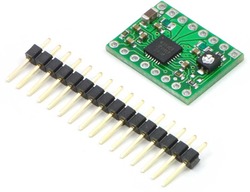 |
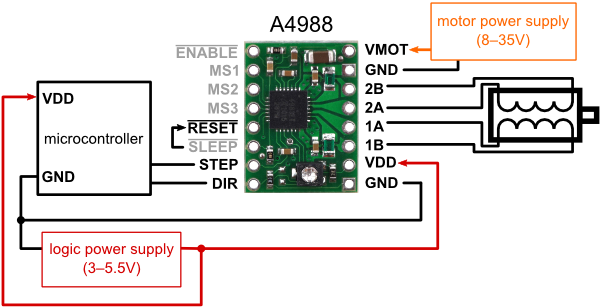 |
| Minimal wiring diagram for connecting a microcontroller to an A4988 stepper motor driver carrier (full-step mode). |
|---|
The driver requires a logic supply voltage (3 – 5.5 V) to be connected across the VDD and GND pins and a motor supply voltage of (8 – 35 V) to be connected across VMOT and GND. These supplies should have appropriate decoupling capacitors close to the board, and they should be capable of delivering the expected currents (peaks up to 4 A for the motor supply).
Warning: This carrier board uses low-ESR ceramic capacitors, which makes it susceptible to destructive LC voltage spikes, especially when using power leads longer than a few inches. Under the right conditions, these spikes can exceed the 35 V maximum voltage rating for the A4988 and permanently damage the board, even when the motor supply voltage is as low as 12 V. One way to protect the driver from such spikes is to put a large (> 50 µF) electrolytic capacitor across motor power (VMOT) and ground somewhere close to the board.
Four, six, and eight-wire stepper motors can be driven by the A4988 if they are properly connected; a FAQ answer explains the proper wirings in detail.
Warning: Connecting or disconnecting a stepper motor while the driver is powered can destroy the driver. (More generally, rewiring anything while it is powered is asking for trouble.)
Stepper motors typically have a step size specification (e.g. 1.8° or 200 steps per revolution), which applies to full steps. A microstepping driver such as the A4988 allows higher resolutions by allowing intermediate step locations, which are achieved by energizing the coils with intermediate current levels. For instance, driving a motor in quarter-step mode will give the 200-step-per-revolution motor 800 microsteps per revolution by using four different current levels.
The resolution (step size) selector inputs (MS1, MS2, MS3) enable selection from the five step resolutions according to the table below. MS1 and MS3 have internal 100kΩ pull-down resistors and MS2 has an internal 50kΩ pull-down resistor, so leaving these three microstep selection pins disconnected results in full-step mode. For the microstep modes to function correctly, the current limit must be set low enough (see below) so that current limiting gets engaged. Otherwise, the intermediate current levels will not be correctly maintained, and the motor will effectively operate in a full-step mode.
| MS1 | MS2 | MS3 | Microstep Resolution |
|---|---|---|---|
| Low | Low | Low | Full step |
| High | Low | Low | Half step |
| Low | High | Low | Quarter step |
| High | High | Low | Eighth step |
| High | High | High | Sixteenth step |
Each pulse to the STEP input corresponds to one microstep of the stepper motor in the direction selected by the DIR pin. Note that the STEP and DIR pins are not pulled to any particular voltage internally, so you should not leave either of these pins floating in your application. If you just want rotation in a single direction, you can tie DIR directly to VCC or GND. The chip has three different inputs for controlling its many power states: RST, SLP, and EN. For details about these power states, see the datasheet. Please note that the RST pin is floating; if you are not using the pin, you can connect it to the adjacent SLP pin on the PCB.
To achieve high step rates, the motor supply is typically much higher than would be permissible without active current limiting. For instance, a typical stepper motor might have a maximum current rating of 1 A with a 5Ω coil resistance, which would indicate a maximum motor supply of 5 V. Using such a motor with 12 V would allow higher step rates, but the current must actively be limited to under 1 A to prevent damage to the motor.
The A4988 supports such active current limiting, and the trimmer potentiometer on the board can be used to set the current limit. One way to set the current limit is to put the driver into full-step mode and to measure the current running through a single motor coil without clocking the STEP input. The measured current will be 0.7 times the current limit (since both coils are always on and limited to 70% in full-step mode). Please note that the current limit is dependent on the Vdd voltage.
Another way to set the current limit is to measure the voltage on the “ref” pin and to calculate the resulting current limit (the current sense resistors are 0.05Ω). The ref pin voltage is accessible on a via that is circled on the bottom silkscreen of the circuit board. See the A4988 datasheet for more information.
The A4988 driver IC has a maximum current rating of 2 A per coil, but the actual current you can deliver depends on how well you can keep the IC cool. The carrier’s printed circuit board is designed to draw heat out of the IC, but to supply more than approximately 1 A per coil, a heat sink or other cooling method is required.
This product can get hot enough to burn you long before the chip overheats. Take care when handling this product and other components connected to it.
Please note that measuring the current draw at the power supply does not necessarily provide an accurate measure of the coil current. Since the input voltage to the driver can be significantly higher than the coil voltage, the measured current on the power supply can be quite a bit lower than the coil current (the driver and coil basically act like a switching step-down power supply). Also, if the supply voltage is very high compared to what the motor needs to achieve the set current, the duty cycle will be very low, which also leads to significant differences between average and RMS currents.
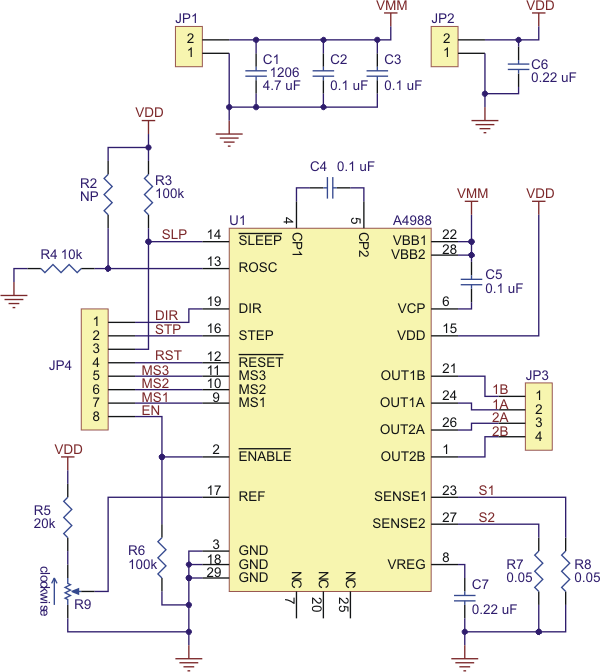 |
| Schematic diagram of the md09b A4988 stepper motor driver carrier. |
|---|
Note: This board is a drop-in replacement for our original A4983 stepper motor driver carrier. The newer A4988 offers overcurrent protection and has an internal 100k pull-down on the MS1 microstep selection pin, but it is otherwise virtually identical to the A4983.
 |
Stepper Motor: Unipolar/Bipolar, 200 Steps/Rev, 42x48mm, 4V, 1200mA |
Data sheet
Manufacturer BTC Korporacja sp. z o. o. Lwowska 5 05-120 Legionowo Poland sprzedaz@kamami.pl 22 767 36 20
Responsible person BTC Korporacja sp. z o. o. Lwowska 5 05-120 Legionowo Poland sprzedaz@kamami.pl 22 767 36 20
Bipolar stepper motor. It has a resolution of 200 steps/revolution (1.8 ° per step), has a nominal voltage of 7.4 V, and draws a current of 0.28 A per coil. Pololu 1207
Bipolar stepper motor. It has a resolution of 200 steps/revolution (1.8° per step), a rated voltage of 10 V, and draws a current of 0.5 A per coil. Pololu 1208
Bipolar stepper motor. It has a resolution of 200 steps/revolution (1.8° per step), a rated voltage of 3.9 V, and draws a current of 0.6 A per coil. Pololu 1204
Bipolar stepper motor. It has a resolution of 200 steps/revolution (1.8° per step), rated voltage of 3.8 V, and has a current consumption of 0.67 A per coil. Pololu 1205
Bipolar stepper motor. It has a resolution of 200 steps/revolution (1.8° per step), a rated voltage of 4.5 V, and draws a current of 0.67 A per coil. Pololu 1206
No product available!
Bipolar stepper motor. It has a resolution of 200 steps/revolution (1.8 ° per step), a rated voltage of 2.7V, and draws a current of 1A per coil. Pololu 1209
No product available!
Bipolar stepper motor. It has a resolution of 200 steps/revolution (1.8° per step), has a nominal voltage of 4 V and draws a current of 1.2 A per coil. Pololu 1200
Bipolar stepper motor. It has a resolution of 200 steps/revolution (1.8° per step), a rated voltage of 4.5 V, and draws a current of 1 A per coil. Pololu 2297
No product available!
Bipolar stepper motor powered with a voltage of up to 12 V and a maximum current of 400 mA. SparkFun ROB-10551
The stepper motor driver with Allegro A4988 (A4988 Stepper Motor Driver Carrier) allows you to supply a bipolar current of up to 2A per phase. The system can be supplied with voltage up to 35V, in the set there is a heat sink. It is compatible with Polol 1182
Pololu High-Power Motor Driver 18v25 CS
Two-channel DC motor driver with an operating voltage from 7 to 35 V and a maximum continuous current of 30 A. It can be controlled by an analog signal, PWM, UART, RC signal or by means of built-in buttons. Cytron MDDS30
Compact stepper motor controller with the TMC2208 system with an operating voltage from 4.75 to 36 V. It offers smooth, quiet operation, high efficiency, various operating modes and easy configuration. It is controlled via the STEP/DIR interface and is an ideal solution for 3D printers and similar applications. BIGTREETECH TMC2208 V3.0
No product available!
Module with a stepper motor driver based on the DRV8434A system. It allows the bipolar motor to be supplied with current up to 1.2 A per phase and with a voltage from 4.5 V to 45 V. Communication via the SPI interface. Pololu 3768
No product available!
The pad for use with shallow Feather series contains two TB6612 chips that allow you to control DC motors or stepper motors. The I2C interface is used to communicate with the overlay. Adafruit 2927
A BLDC motor control board with a Field-Oriented Control algorithm, based on the ESP32 WROOM 32D module. It supports 12-24V DC, two channels with a peak current of 12A, and dual-channel real-time current sensing with a range of ±33A. Support for Hall, SPI, I²C, ABI, and analog sensors provides flexible integration in projects such as robotics, balancing vehicles, and gimbals. Makerbase MKS ESP32 FOC V1.0
KAmodMPC17C724 is a module with a double MP bridge bridge type MPC17C724. The system allows you to control two DC brush motors or one bipolar stepping motor. The controller operates at a voltage range of 2.7 - 5.5 V and can work with motors with power consumption up to 0.4 A.
Module with a stepper motor driver based on the DRV8434A system. It allows the bipolar motor to be powered with a current of up to 1.2 A per phase and can be supplied with the voltage from 4.5 V to 45 V. Pololu 3765
No product available!
Dual-channel electric motors controller (H-bridge) Arduino Motor Shield Rev3 with L298 for controlling two DC motors or one stepper motor with the possibility of using an electronic brake.
No product available!
Pololu Simple High-Power Motor Controller 18v15
No product available!
Single-channel DC motor controller that allows the motor to be controlled with a voltage range of 6-30V and a current of up to 20A. Allows engine speed control using PWM signals. MD20A cytron
3-channel brush motor controller module with PWM signal mixing function. It allows you to control three DC motors with a current consumption of up to 3 A per channel
Pololu G2 24v12 High Power is a miniature DC motor controller. Driver\'s power supply: 6.5 ... 30V. Current capacity of the module: 12A. The module has protection against back voltage and overvoltage. Pololu 1364
Brushless DC motor (BLDC) driver. It can operate motors powered with a voltage from 6 to 20 V with a current consumption of up to 3 A
DC motor driver with voltage 6.5..40V and maximum continuous current 21A. It has the ability to easily implement the feedback loop and numerous control interfaces. Polol 3149
No product available!
The Tic 36v4 USB Multi-Interface High-Power Stepper Motor Controller makes basic control of a stepper motor easy. Pololu 3141

A4988 Stepper Motor Driver Carrier
